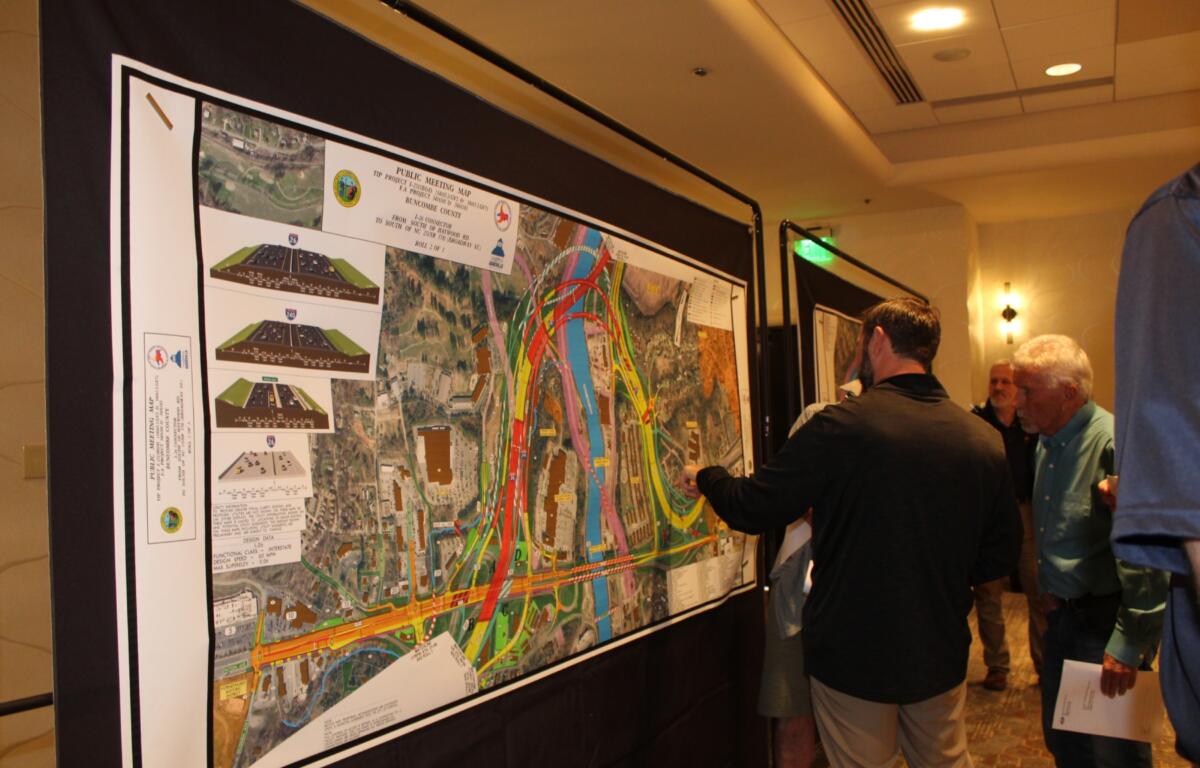ASHEVILLE, N.C. (828newsNOW) — Hundreds of people attended a public meeting Thursday to learn more about the Interstate 26 Connector project. Some were focused on how the North Carolina Department of Transportation’s proposed changes could affect their homes, while others were more concerned about the decision-making process behind those changes.
“Those changes concern us. The way they made those changes concerns us,” Sonia Marcus, of the I-26 Citizens’ Coalition, said.
In February, the NCDOT announced a redesign for the northern section of the project. The revised plan, which includes a flyover bridge across the French Broad River, is expected to cut costs by $63 million, lowering the total estimated cost to $1.023 billion.
The new design elevates I-26 above Patton Avenue, replacing an earlier plan that would have routed the highway beneath the city’s main thoroughfare.
“I know there’s a petition against the flip,” NCDOT Deputy Director of Technical Services Derrick Weaver said. “But then I’ve also gotten some emails, not directly but that other people have got, and folks are just like let’s just build it.”
The project has been in the pipeline for decades, and many thought the design had been set.
“There’s a lot of people who have been working on this for a long time who are really distressed about the changes that they’re making at the last minute,” Marcus said.
Marcus lives on Westwood Place near Hazel Mill, an area directly impacted by the project.
“I just canvassed in my neighborhood, one of the most impacted areas as far as the overpass is concerned,” Marcus said. “When I spoke to a bunch of my neighbors, I stopped at 13 different households in that area right there, and many were just shocked by what they were seeing online about there having been changes to this project that had not been communicated to us as the most impacted homeowners and residents. So, yeah, there’s a lot of concern.”
Several people were concerned, getting help finding their homes on the maps scattered around the Grand Ballroom at the Renaissance Asheville Hotel.
“I want to see where my house is,” one woman said, pointing to a map while an NCDOT employee searched for her address.
Once he pointed it out to her, she said, “I can go now. That’s all I needed to know, I’m safe.”
The reason for the changes
Weaver said early proposals for the project came in well above initial estimates.
“Our original cost estimate was around $800 million,” Weaver said. “But the lowest bid came in at about $1.2 or $1.4 billion, and the highest was around $1.8 billion. That put us way over what we had available in terms of funding.”
Faced with limited resources, NCDOT chose the lowest bid and launched an optimization and refinement (O&R) process to find cost-saving opportunities.
During that process, the proposal was made to put the interstate over Patton Avenue instead of under it — a shift that would be beneficial in terms of timeline and utility work.
“That change allowed for construction to begin while utilities were being relocated,” Weaver said. “It could save a year and a half to two years. With the interstate going over, we can phase construction more efficiently. Otherwise, with Patton going over, we’d be looking at more phases and more complicated traffic movements — about nine phases instead of four.”
The project is currently undergoing a re-evaluation in coordination with the Federal Highway Administration to determine whether the design changes require reopening the environmental review. So far, Weaver said, the answer appears to be no.
As part of the re-evaluation, NCDOT is presenting changes to the public, though Weaver noted that switching back to the original “Patton over” design isn’t financially viable.
“If we went back, the cost would jump again, and we just don’t have the money for that,” he said. “It would likely mean shelving the project and competing for funding again, which would delay it significantly.”
Room for negotiation
Concerns from residents have included how the area under the overpass will feel — particularly in terms of lighting, safety and aesthetics. Weaver acknowledged those worries and said there are ongoing conversations about enhancements.
“There are opportunities for public art, lighting and different abutment designs to discourage homeless encampments,” he said. “It’s not perfect, but we can make it better.”
One notable design change is the removal of an interchange on the east side of Patton Avenue, near downtown Asheville.
“That change supports the city’s long-standing desire to make Patton Avenue feel more like a boulevard,” Weaver said.
As for when full-scale construction will begin, Weaver said it’s still at least a year away.
“We’re finalizing the noise report and evaluating sound walls — whether they need to be taller or shorter,” he said. “The final design won’t be complete until sometime next year.”






